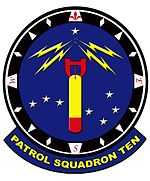VP-10
| VP-10 Red Lancers | |
|---|---|
 Vp-10 Unit Insignia | |
| Active | 1930-Present |
| Country |
|
| Branch |
|
| Type | Squadron |
| Role | Anti-Submarine Patrol |
| Part of | United States Navy |
| Garrison/HQ | Jacksonville Naval Air Station, Jacksonville, Florida |
| Nickname | Red Lancers |
| Decorations | 2009 Battle "E", Golden Wrench |
| Commanders | |
| Commanding Officer | CDR Charles M. Stickney |
| Executive Officer | CDR James P. Johnston |
| Command Master Chief | CMDCM Teri E. Zehnacker |
| Aircraft flown | |
| Patrol |
Martin T4M-1 P2Y PBY-5 Catalina P-2 Neptune (P2V) P-3C Orion |
The VP-10 "Red Lancers" are a U.S. Navy P-3C squadron based at Jacksonville Naval Air Station Jacksonville, Florida, USA.
History
Pre War Origins
Patrol Squadron TEN, United States Navy, is considered to be one of the original Patrol Squadrons in aviation history. Nicknamed the RED LANCERS, the squadron was first established on July 1, 1930, with the commissioning of Patrol Squadron 10S. The squadron initially flew the Martin T4M-1, a single engine torpedo bomber. Other aircraft flown by the squadron from 1930 through World War II include the Martin PM1 flying boat, the P2Y and PBY-5 CATALINA. 1934 - Patrol Squadron 10F flies the first non-stop formation flight from San Francisco to Pearl Harbor, Hawaii, arriving Jan. 11. Patrol Squadron TEN then served in the Pacific through the end of World War II.
World War
On December 7, 1941, eight of the squadron's twelve aircraft were destroyed or damaged in the Pearl Harbor attack. On June 4, 1942, a squadron PBY-5A "Catalina" aircraft flown by LTJG Howard Andy and LT William Chase was the first to locate and report the positions of four aircraft carriers of the Japanese Navy's striking force on their way toward the island of Midway. This action led to the battle of Midway.
Post & Cold War
With the war's end, the squadron was decommissioned on January 25, 1946. Following re-commissioning in March 1951, Patrol Squadron TEN began flying the P2V Neptune aircraft and was stationed in Jacksonville, Florida. The squadron then moved to Brunswick Naval Air Station, where it remained until late 2009 before coming full-circle back to Jacksonville, Florida. In 1965, the RED LANCERS began a two-year transition to the P-3 airframe. The P-3A ORION aircraft was delivered and a year later the P-3B arrived which served the squadron until 1980 when the squadron transitioned to the P-3C Update II.
Modern Day
In 1995, Patrol Squadron TEN transitioned to the P-3C Update III, which was flown through the final days of the Cold War. After completing transition to the P-3C Aircraft Improvement Program (AIP) in late 1998, the squadron deployed to the European theater of operations in support of the Kosovo conflict and were the first to conduct P-3 overland strike operations. In the 2000s, VP-10 has deployed multiple times in support of Operation Enduring and Iraqi freedom, and more recently maritime security and anti-piracy operations in support of CJTF-HOA. Today the RED LANCER team continues to set the standard supporting operations and exercises throughout the world employing five variants of the P-3C ORION capable of carrying and delivering a wide variety of naval mines, torpedoes, missiles, and bombs.
BRAC 2005
The Base Realignment and Closure Commission recommended that Brunswick Naval Air Station be closed and the squadron be moved to Naval Air Station Jacksonville. The squadron completed the home port change in December 2009 following their return from a combined Central and Africa Command deployment.
External links
See also
| |||||||||||||||||||||||||||||||||||||||||||||||||||||||||
